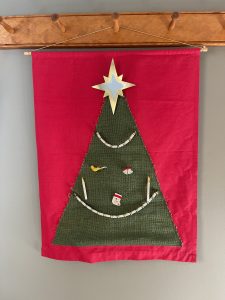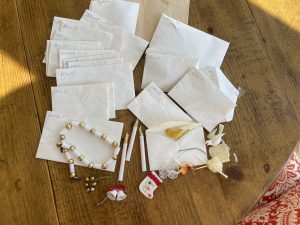
By Elizabeth Wulfhorst
As the Christmas season rapidly approaches, the proliferation of a specific kind of gift has reached new levels. The lowly Advent calendar, once made of cheap cardboard and offering only a festive image or saying behind each of its 24 small, perforated “doors,” has grown – oh, has it grown. From chocolates to makeup to candles, wine, art supplies, foodstuffs and more, it would be difficult to find a brand that isn’t producing an Advent calendar this year.
Advent is a uniquely Christian event, begun in the 4th or 5th century in Europe as a season historically used to prepare new Christians for baptism in January. It wasn’t until much later that the Advent season became linked to the birth of Christ.
As with many traditions woven into the fabric of the season, the idea for the Advent calendar began with German Protestants as a way to count down the days to Christmas. According to NPR, “Some families hung up a devotional image each day, which led to the creation of the first known handmade, wooden Advent calendar in 1851.”
This year Advent season begins Sunday, Dec. 3, but most Advent calendars, now secularized, cover the period of Dec. 1 through the 24th or 25th. Since the length and dates of Advent change every year, having a fixed time period made it easier for companies to mass-produce calendars.
Much like Lent, Advent is intended to be a season of fasting, but you wouldn’t know that from the myriad offerings of calendars with food and drink stuffed inside. Fancy trying 24 different whiskeys in December? There’s an advent calendar for that. Want to indulge in a different piece of chocolate each day of the month? Pick a brand – Godiva, Tony’s, Lindt, Divine, etc. – you’re guaranteed to find an Advent calendar with their tasty morsels inside. Is jam your jam? How about wine? Yes and yes.
Beware: the excess of choices comes at a cost. A literal cost. While you can still find some Advent calendars for under $10 (Trader Joe’s sells one with fun, festive scenes and pieces of chocolate from a French-Canadian chocolatier for $1.29), many clock in at $50 or more. One from the perfumer Jo Malone will set you back $500. Sam’s Club is offering one filled with 25 pieces of jewelry for $3,800.
I have been purchasing Advent calendars for my family for a few years now and am astounded by the array of options. Years ago, when my daughter was younger, we had an “old-fashioned” wooden box calendar, bought at a small shop in the Grove. Each year I would search for 25 little gifts that would fit behind the doors – wrapped chocolates, lip balms, inexpensive earrings, mini nail polishes. The travel and trial sections of the drugstore were great places to find those items, but the Advent calendar was never really about the gifts. It was about the practice of opening a new door each morning – the anticipation and the excitement of the season, condensed into this small ritual.

As I searched this year for the perfect calendar for my daughter (chocolate or a puzzle?), my sister-in-law (cookies or wine?), my nephew (LEGO Harry Potter or Star Wars?) and others, I was struck by another memory from my childhood.
Sometime in the 1970s my grandmother, one of 13 children who grew up on a farm in Pennsylvania and never met a quilt she couldn’t sew, meat she couldn’t cook or a canvas she wouldn’t paint, gifted me a homemade Advent calendar. Simply a rectangle of bright red canvas with a plain triangle “tree” of green burlap sewn onto it, the calendar hung from a gold cord attached to a dowel. She’d even had the forethought to sew weights into the bottom corners to ensure the sheet hung straight and true. Accompanying the hanging tree were 25 plain white envelopes which she had labeled in her perfect old-school cursive from Dec. 1 to 25. Each envelope contained the smallest tchotchke with a hook glued to the back – candles, strings of beads, animal figurines, bells, wreaths and more. Some she had made, others were purchased, probably at the craft store. Each day I opened the appropriate envelope and each day I was delighted by what I found. I remember spending an inordinate amount of time trying to decide the perfect placement on the tree, which began the month bare and filled up quickly. I became so enthralled my mother had to institute a “no change” rule (once an item was hung, that’s where it stayed) and threatened to move the gift unveiling to the afternoon after one too many near misses of the school bus.
That Advent “calendar” tree brought me such joy for years and it probably cost a few dollars. But the time she invested in making it for me and the memories she left me with are priceless.
Homemade gifts are making a comeback. Why not try fashioning a similar Advent calendar this year? Inflation may mean the fabric and decorations cost much more than they did in 1975, but as it is reused each year the cost will decrease as the sentiment rises.
If you aren’t a crafter but are into the latest tech, you probably won’t be surprised to learn there is an online version of the homemade Advent calendar available. You can enter messages and upload photos and videos to the site, then email a link to anyone you’d like to gift it to. Each day they can go on the site and “open” the door by clicking on it and get a special message from you. This is a great way to stay in touch with far-flung family members throughout the season. Best of all? It’s free! Go to calendar.myadvent.net to get started.
So whether you DIY it or shop ’til you drop, why give just one gift this year when you can give dozens at once? And maybe even have your holiday shopping finished before Thanksgiving.
This article originally appeared in the November 16 – 22, 2023 print edition of The Two River Times.














